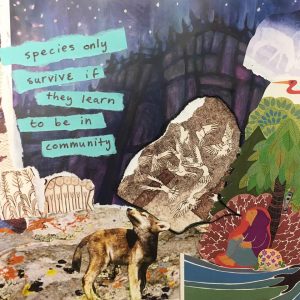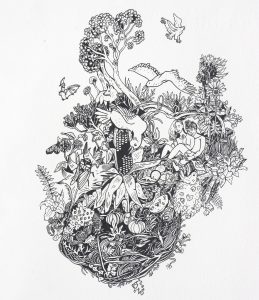Over the past few months, I have been a part of three conversations with groups of thoughtful, fearless, and committed EcoFaith Recovery leaders about what it means to integrate the practice of Restoring Balance into the fabric of our lives. Practicing Sabbath in times like these can feel complicated: who are we to rest, restore, dream, re-fill our wells while the world is filled with so much despair?
It seems that so often when people of privilege take the time to be really committed to personal Sabbath space and restoration, the burden of the work that still needs to be done falls on the folks surrounding them. Pastor Robyn shared a longing for a more justice-oriented way to understand Practice #7 that was different than the pervasive, isolated understanding of self-care that seemed so prevalent in the communities around her. How do we build systems of Sabbath? Do we have imaginations big enough to say that we can rest (we know that we need to rest) and find ways that the work does not have to fall disproportionately on someone with less power in the work place, in the movement?
I often think of my partner, Nathan Holst, as someone with a lot of moral imagination around Sabbath. Nathan has spent a lot of time visioning what enacting the Older Testament practice of a Sabbath Year could really look like, asking, what if every year he saved up 1/7 th of his salary so that every seventh year he could take the space to reflect, evaluate, and restore in order to discern if he was really showing up how he was meant to in the world. In addition, what if, in relationship to someone with less economic privilege in the community—maybe a movement organizer of color doing most of their work on a volunteer basis—Nathan shared that Sabbath year, taking 6 months of restoration so that other person could also have 6 months of paid Sabbath?
I am inspired by dreams such as these. Of course, there is much community vision-weaving and story-sharing that would need to be done to make something like this possible (what workplace would let you take 6 months off every 7 years?). In a small group that Nathan and I gather in every Monday night (and that EcoFaith Intern Liz Fifield also attends!), we have been reading “The Biblical Vision of Sabbath Economics” by Ched Myers out loud to one another a chapter at a time and discussing as we go along. A few Mondays ago my parents were in town and got to join in on the conversation. In the course of one evening where we were sharing Sabbath vision like the one of Nathan’s described above, my parents discerned and offered that maybe their place in making Sabbath space possible (in even a small way) could be to do childcare for this group when they move to Duluth in a year. To them, stepping up in this way as a retired couple seemed to be a good balance so that this group of young people and parents could have time to build relationship and discern community action together.

Community—collage by Sarah Holst, words by adrienne maree
brown from her book emergent strategy: shaping change, shaping worlds.)
There is biblical precedent that Sabbath must be honored communally, not just individually. Community allows Sabbath to be Sabbath. Our call in this recovery work is two-fold: to topple destructive systems of empire and to strengthen the village. (My mantra of hope is often, “Empires fall but the village remains.”) To strengthen our villages, we have to strengthen our relationships. Pleasure activist adrienne maree brown writes, “The strength of our movements is the strength of our relationships.” To strengthen our relationships, we strengthen ourselves.
Last fall, Nathan and I were invited to attend a Grief Ritual held by two Anishinaabe elders at the Ma’iingan (Wolf) Prayer and Cultural Camp (a support camp for resistors of the Line 3 pipeline). One of the central messages discussed that night was this idea of concentric circles: the innermost circle being the self, then moving outward into the community, and the public sphere (not unlike the tiers of the EcoFaith Practices!). If the circle of self was unhealthy—given to anger or despair or addiction—then what that person was bringing out into the movement spaces would also be unhealthy. The elders encouraged those gathered to do the “circle work”, to take the time to focus on their own healing so that the movement for the water and the land would not be dragged down by interpersonal wounds and trauma.

Sacred Life—drawing by Sarah Holst
I am reminded that this work of restoration is cyclical. Unhealthy power comes into play if one person is always stepping back so that others have to step up. But, if we take turns, if we deeply listen to and respond to one another’s needs (and do the brave work of knowing and naming our own!), we are able to create a healthy, restorative dance. The rhythms of creation mirror these cycles. During the time of the last conversation I had about Practice #7 with EcoFaith leaders, it was the solstice. I had just received my seasonal newsletter from the herbalist Fireweed and Nettle in which she was discussing how even in times of political overload, the solstice is meant to be a time of standing still. We do not accomplish anything by rushing forward without observation and reflection. In the time of solstice, she reminds us, that we are not meant to move forward, only examine what the Sun illuminates. When you stand still, the living world of which you are part and particle envelopes you in itself, whispering the meanings of your life from your very own heart. (Or, to put it another way, as organizer with the Center for Prophetic Imagination Mark Van Steenwyk recently said, “Social analysis without discernment is dead.”) Perhaps especially in times where we are pushed and pulled in a thousand directions, we need to slow, pray, invest in relationships, take time to imagine and build sustainability, healing, and hope.
Singer songwriter Paola Suculima writes, “What will painting help with? They said. How will we rebuild with poetry? They mumbled. What good does music do? They questioned. As she scribbled prayed sang danced and painted up a storm RISE RISE UP family keep doing what you are doing and MORE. Speak up. Express. Share. Act NOW. Get real good at what you’re doing because we are gonna need more of what ya bring when the sh** hits the fan!”
So, friends, surround yourselves with beauty. Talk to your communities about what you require for restoration. Make someone else a meal or do their dishes so they can sit in their backyard and listen to the birds for a half an hour. Redistribute the wealth of restoration that you can. I believe that we can do this together: I am so glad that you all are a part of my village.
